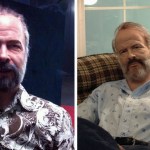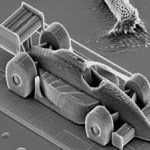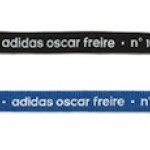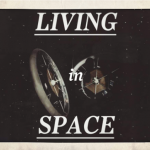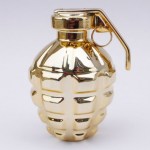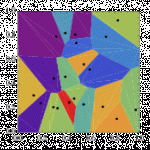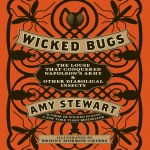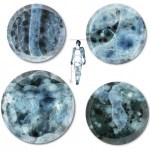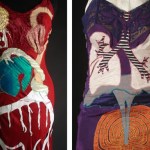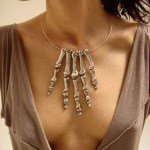design
It was an unexpected journey, from the George W. Bush Shake, the Barack Obama Hug to the Harlem Shake.
Appreciation from the President of the United States is one of the highest honors any American can receive. No, it wasn't me, but the best part is that it was one of our students.
I have been very fortunate in my own education having learned from two mentors awarded the National Medal of Science (Prof. Tobin J. Marks and Prof. Stephen J. Lippard.) Each received a hearty handshake from President George W. Bush. Perhaps some of my work in their labs helped get them there, along with a…
Last week, I wrote a piece for Motherboard about an android version of the science fiction writer Philip K. Dick. The story of the android is truly surreal, stranger than even Dick's flipped-out fiction, and I recommend you pop over to Motherboard and mainline it for yourselves. For the piece, I interviewed the lead programmer on the first version of the PKD Android, Dr. Andrew Olney. Aside from bringing science fiction legends back from the dead, Olney is an Assistant Professor in the Department of Psychology at the University of Memphis and Associate Director of the same university's…
This is a 285 micrometer racecar, printed at the Vienna University of Technology. Credit: Vienna University of Technology
Imagine a car small enough for a dust mite. Crazy, right?
Well, with new printing technology, this just might be possible.
The 3D printer uses a liquid resin, which is hardened at precisely the correct spots by a focused laser beam. The focal point of the laser beam is guided through the resin by movable mirrors and leaves behind a polymerized line of solid polymer, just a few hundred nanometers wide. This high resolution enables the creation of intricately structured…
Ads of the World.
Can business cards evoke creativity, spark interest? Standard business cards seem outdated, dull, uninspiring. Liberate your shoelaces, your flexagons!
Consider shoelace business cards for Adidas employees, a highly creative approach to grabbing attention, and importantly, explaining what you do for a living.
A design colleague of mine, Prof. Rose Gonella, suggested that I use a flexagon business card, because my job involves so many facets - teaching, research, administration,...
It's easy to make a flexagon:
Give up those dull business cards! What's your design?
"I read this book. It's pretty good even if they made it in a week. Worth the fifty bucks, easy."
Bruce Sterling
In February of this year, I had the distinct pleasure of being invited to the STUDIO for Creative Inquiry, a zygote of an institution nestled between departments at Carnegie Mellon University, to work on a strange collaborative project called a "booksprint." A booksprint, I discovered, is a fairly new practice, derived from the world of open-source software "codesprints." In this version, a group of writers work exhaustively for a week on a shared project, which is then made…
As I begin the final push on _Making Home_ my book on Adapting in Place (out next spring), Aaron and I will be offering the first ever "Advanced AIP Class" running from Tuesday, September 20 to October 25th. The class will build on the basic Adapting-In-Place skills that we've been talking about all these years in my classes, the blogs, etc... - triaging your situation, thinking about scenarios, and building both personal and community resilience, but this class moves beyond the basics into the larger question of how to make a life that both provides you some insulation from tough times, but…
Annalisa Crannell, a professor at Franklin & Marshall, has a great essay at Inside Higher Ed on the math of perspective. Crannell, who thinks her students are generally more scared of drawing than they are of math, uses the "fencepost puzzle" to get her students working through the proportions that create realism:
We mathematicians tend to stare at the paper, hoping an answer jumps off the page at us. Artists pull out their pencils and start doodling, often stumbling upon a solution almost by accident. The artists have learned to overcome their fear of drawing something that is "wrong,"…
This little video from Abebooks is the closest I've ever gotten to flipping through a copy of the Codex Seraphinianus. What a truly weird book.
I particularly love it when the staid narrator reveals his "favorite" illustration - a roller skater murdered by a monstrous pen. What?!
The Codex reminds me of If You're Afraid of the Dark, Remember the Night Rainbow by Cooper Edens. My mom had a copy and I used to flip through it as a child, confused and not a little disturbed. I still took things too literally to appreciate the visual non sequiturs, combined with the nonsensical text ("If you…
In the mid-1970s, the U.S. State Department prohibited the internal use of the term "space colony," due to the global bad reputation of colonialism. Instead, the government opted for "space settlement." Of course, as Stewart Brand pointed out at the time, the last thing you do in space is settle. Quite the opposite! Making the decision to explore space -- and live there -- is just about the most unsettled act a human can commit.
There have always been two camps on this issue. First, the unsettled, like Brand: the science-fiction aficionados, capitalists, rocketry geeks, macrocosmic thinkers,…
Love can be explosive. This may be a bit much, or it may be just right.
From Molla Space:
War is destructive and bombs take away lives. But these beautifully sculpted ceramic love grenade coin banks are designed and made to plant seeds for future growth and prosperity. Convert your love to change and save it in "A Love Grenade" and donate it to those who are in need.
Part of proceeds benefits Biaugust's cause A.N.S.W.E.R. (Act Now to Stop War & End Racism).
I fully support efforts to promote human rights. This particular example is visually provocative, and raises an interesting…
This is a guest post by Prof. Robin Landa, Distinguished Professor, Robert Busch School of Design at Kean University and author of "Advertising by Design: Generating and Designing Creative Ideas Across Media."
Natural movement is a matter of survival for animals. We rely heavily on natural movement to go about our daily lives--whether it is to reach up to place a suitcase in an overhead compartment on an airplane, take a walk, run for a bus, or bend down to retrieve an object. However, few of us, other than dancers and athletes, execute our movements thoughtfully, with more than a nod to…
Philosopher and mathematician René Descartes proposed some curious diagrams in 1644. A biologist looking at these shapes might think of living cells under a microscope:
Source.
Compare these shapes to epidermal cells {in this case, the epidermal surface of lamprey larvae. Note that this image is from the wonderful Cell Image Library.)
These designs, also known as "Voronoi diagrams," have found useful applications in a wide range of fields, including medicine such as:
...finding the best location for a hospital based on the locations of surrounding residents can
be obtained by using…
Amy Stewart's new book Wicked Bugs: The Louse That Conquered Napoleon's Army & Other Diabolical Insects takes a fairly trivial concept - a collection of historical anecdotes and icky factoids about dangerous insects - and executes it remarkably well. The book is well-written and has a non-cloying sense of humor ("she's just not that into you," begins the section relating how female praying mantids eat the males). Briony Morrow-Cribbs lends her insect illustrations (see a NYTimes slideshow of her ink illustrations here), and Anne Winslow's design plays off the concept of a vintage…
This 1967 IBM propaganda film, "Paperwork Explosion," couples an eerily deadpan refrain of "more time on paperwork," with a creepy pseudo-country neighbor* urging us to embrace Progress.
The film's frenetic soundtrack and abrupt transitions embody the familiar hysterical nervousness of an increasingly automated era, while striving the whole time to convince us that technology will relieve the pressures of the modern workplace, allowing us to "think" instead of "work". Looking back, of course, it's clear that technology instead cranked the pressure up. If writers like Nicholas Carr are to be…
. . . let the table settings do the talking (and the grossing out) for you! These Consumption Dinnerware plates by Leah Piepgras "are a map of the digestive tract, from mouth to anus:"
I'm trying to decide if these plates have a future as a diet aid.* Visualizing the eventual chyme-ish fate of a bolus of taco salad might just induce me to eat less. . . on the other hand, the dreamy blue watercolor palette makes me think of snowflakes, not chyme and gall. And I think I've done too many dissections for a medical illustration to have much of an effect.
Via the design blog CollabCubed.
*you…
Thanks to Coilhouse, I just learned that artist Theo Jansen is producing 3D printed baby versions of his amazing strandbeests - wind-powered kinetic sculptures that "walk" on their own.
If you don't remember Jansen, here he is with his eerie, lifelike beests, which he calls "new forms of life:"
Of course you want one, right? Well, now you can get one! A small 3D printed version, at least, without all the wings and propellers. Here's a video of a little strandbeest running around on a string. Give it five seconds, and you won't believe this little guy isn't actually alive:
Squee! (Yes, I'…
Scapular Art Dress
Rachel Wright
I'm about to go back offline again because I don't feel up to blogging, but I had to share this find from my friend Shana - she does know what belongs on BioE! These are one-of-a-kind art dresses by artist Rachel Wright (Toolgrrl Designs on etsy). Wright says,
This piece is called "Scapular" because of the wing-like velvet shoulder blades that grace the back. The slip is a rayon slip probably from the 50's that I dyed a scarlet red. I then used a variety of different fabrics for the appliqué: velvet, silk for the many petaled breast & kidney, a recycled…
Beautiful video imagining the future of augmented, prosthetic sight, by Superflux for the Human+ exhibition:
Song of the Machine from Superflux on Vimeo.
You can read more about the science behind retinal prosthetics in a great article in the Guardian by one of the project collaborators, Dr. Patrick Degenaar.
I've been remiss in not recommending my temporary Scienceblogs scibling "Art and Science Learning" to those of you who are, like me, interested in the sciart intersection. However, I have to say I am not 100% behind its latest (and quite popular post), by Robert Root-Bernstein. It starts,
Most people are at a loss to be able to identify any useful connections between arts and sciences. This ignorance is appalling.
Hmmm. Do you think that's really true, much less "appalling"?
I'm not so sure. I do think it's true that people tend to view arts and sciences as distinct disciplines, which is…
Haute Macabre found artist Celina Saubidet on etsy, where she sells silver-plated bronze "osseous jewelry" from her shop Joyeria Osea. I think this skeletal hand is pretty over the top, but hey - sometimes you need a little drama. Check out her fingerbone rings for a more subtle anatomical statement.
